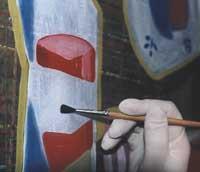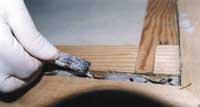Michelangelo must also clean his face
2004/01/01 Roa Zubia, Guillermo - Elhuyar Zientzia Iturria: Elhuyar aldizkaria

How much would you pay if the picture you want to see the entrance to a museum was damaged? A lot? Nothing? Art has many interpretations. For example, the prestigious Rene Magritte refused to keep the picture and was in favour of letting the work age. That is an option, but the usual opinion is different.
Normally we see with good eyes the restoration of the paintings; if it can be preserved as the day that was painted to a picture of yesteryear, we want it. We want to see it as the author saw it at the time of its completion. It would be a work of authenticity. But that can also bring surprises.
Can one know what an ancient work was like at the time of its completion? It is usually very difficult. In the Sistine Chapel, for example, when the frescoes of Michelangelo were restored, an intense debate arose; the results were very fresh and luminous, but how were they originally? Were they dark or lost the light over time? Many arguments were used during the debate, but no one could go to 1510 to see the 'original' work.
From wall to fabric
It is very difficult to make frescoes, since the painting has to be absorbed by the newly laid plaster, but the advantage of this technique is sustainability, since physically the painting is part of the wall. However, for the same reason, the work remains subject to the influence of the atmosphere and deteriorates over the centuries.

For this reason, in some cases the frescoes have been extracted from the wall and have been transferred to the fabrics. This is a complicated process, but in some cases necessary: a fresh cloth is glued with a strong adhesive; then it is extracted with the fabric; the plastering that comes out in that process, that is, the 'piece of wall', which has a thickness of two or three millimeters; finally, it is glued to a canvas by a casein adhesive.
Extraction, refining and gluing to a frame. Through this process many of the churches' works of art have been brought to many museums. From then on, experts show them and take care of them like other paintings.
'Normal' pictures
However, in general, the paintings are not painted on the wall, most rely on a canvas, that is, on a fabric of one type or another. Finally, from the restorer's point of view, the painting is an emulsion of substances (paint) mixed on a fabric, with varnishes and other products. And, therefore, over time all of them degrade, and even the degradation of one component can accelerate the process of deterioration of others. Often, as the support ages, for example, this problem affects the state of the painting itself. What can the expert do? It is better to analyze the damage of the factors affecting the picture.

Light and atmosphere are risk factors for painting. Light, ultraviolet and infrared rays, above all, trigger photochemical reactions and other degradation processes in paint components and fabric fibers. Moreover, the atmosphere acts with light due to the presence of oxygen, air temperature, humidity, dust and pollutants.
Naturally, high oxygen concentrations facilitate oxidation processes and, together with light, yellow colors. Degradation is faster when temperature and humidity are high. On the other hand, the canvas loses tension if it absorbs and pours water.
It would be best to keep the pictures in a place without light and protect them from the atmosphere, but of course, under those conditions you cannot see the pictures. Therefore. The pictures are not fully protected. There are bacteria, fungi everywhere. And the picture is a large group of edible substances for which insects and sometimes mice should not be forgotten. Restorers have often collected plastered pictures. In these cases, in addition to cleaning, these works must be treated with bactericides and fungicides, without prejudice to the painting itself.
Poor care
Light, atmosphere and microorganisms are natural and obligatory agents. However, in the restoration of the paintings it is necessary to deal with many other factors. Experts have seen everything, sometimes because the works have not been preserved or preserved correctly, and sometimes because the work has suffered real attacks: cuts, blows, abrasions, influence of chemicals and, in some cases, even accidents.
The case of the church of Assisi, for example, is very striking. There, among other things, were exhibited frescoes by Giotto, one of the most attractive shows in northern Italy for painting lovers. So they restored the works. But on September 26, 1997, an earthquake struck the area. The frescoes did not suffer agitation and fell from the ceiling. Four people died in the accident and the works were broken into 120,000 fragments on the church floor.

They have renovated much of their works, so they have had to rebuild them with the help of a large computer. They still have it long and not everything will recover. But restorers are making a great effort to get the best results. The project has included many resources and money, certainly more money than to fix the houses of that territory.
Tissue restoration
In general, the resolution of support problems is not usually so expensive, but it is always expensive. A diagnosis of the damage will be made before starting the picture. Know the state of the fabric of the canvas.
To do this, being the tissue made of long fibers, they analyze the rupture of the same, that is, they measure the length of the molecules. If the tissue is severely damaged, the electron microscope is used to analyze the fibers. The canvases have been traditionally made with cotton, linen, jute or hemp, to which today we must add synthetic fabrics. Restorers know perfectly the characteristics of all these materials, including degradation processes. Therefore, the state of the tissue is easily identifiable from the results of some conventional analyses: nuclear resonance, infrared spectroscopy and, above all, the determination of the viscosity of the fibers.

This information will help the expert decide the treatment of the fabric. Apply the adhesive, stretch it through heat and humidity, reinforce the canvas support, who knows. In the worst case you will need to add a new fabric to the original to hold it.
Where is the measure? What if you get overly violent treatment? What if it hurts what was right? What if you don't get what other experts consider good?
Restoration of painting is very difficult, necessary, for many, but difficult. If not, ask us again: How much would you pay if the picture you want to see the entrance to a museum was deteriorated?
Gothic cathedrals made a breakthrough in architecture. Among other things, the way to build walls with giant windows was invented, allowing them to build bright churches that feel small. These windows were filled with colorful stained glass to reinforce the inner mystical effect.

But, of course, time makes those stained glass windows spoil. They lose color and loose the structure that holds the pieces of glass. Therefore, these glasses must be removed, cleaned, sometimes colored, protected and placed in place. If possible, broken parts should also be replaced.
In this process, restorers also face another effect. Although the glass is solid, over time it behaves like a fluid; it is a room that descends slowly. Therefore, it falls, little by little but falls. Therefore, the bottom of the pieces of glass to be restored is "thickened". The material has been conquered. This piece of glass must be given the proper shape again, eroding somehow this material from the bottom.
Wear or replacement? It is a decision of the expert. Once eroded, the glass will be thinner than the original, while if replaced, in no case, it will be the same as the original. However, it is a war against aging. And that war has disappeared from the beginning.
Does it exist? It is very difficult. At some point it is possible to find a suitable treatment and varnish, but the restorer has no universal varnish that serves everything. Varnishes are oil blends and resin solvents, so changing components and proportions can prepare thousands of options. Therefore, it seems almost impossible to prepare one suitable for everything. The varnish should be protected from dust, abrasions, etc. But it also has to have many other features. It must be extensible in thin, colourless, persistent, permeable and flexible layers so as not to depend on the deformations of the frame, not to shrink during drying, with barrier for ultraviolet rays and, if all this was not enough, easy to remove for future restorations. Is there any magic formula for this? |

Gai honi buruzko eduki gehiago
Elhuyarrek garatutako teknologia





